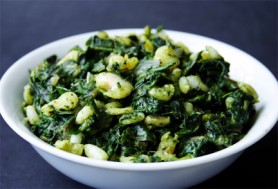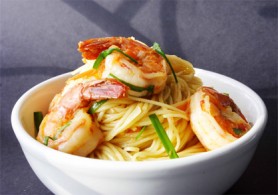The other day, a friend of mine threw up her hands in exasperation and exclaimed, “I love eating shrimp but I hate cooking it! It always turns out hard!”
 “Ah,” I said, “that’s because you are overcooking it.”
“Ah,” I said, “that’s because you are overcooking it.”
“So how long should I cook it for then?”
“That depends,” I said, and explained further.
In Guyana, a regular way to cook vegetables is sautéed with baby shrimp. On any given day you can hear someone say that they’ve cooked pumpkin and shrimp, okra and shrimp, bigan (eggplant) and shrimp, karaila (bitter gourd/melon) and shrimp, callaloo (spinach) and shrimp etc. Like my friend, I too used to have problems with cooking the shrimp, particularly with the vegetables, I could never seem to get the shrimp to remain as plump as my mom’s when she cooked. I couldn’t remember seeing my mom doing anything different than how I was preparing the vegetables and shrimp, but then again, she would have been cooking those meals at a time when I would have been at school or work, for it was after all, weekday food.

On my first trip back to Guyana having moved to Barbados, I requested one day that my mom cook dhal, rice and fried (sautéed) callaloo and shrimp. It so happened that I was home on that day when she was preparing the meal. I walked into the kitchen to get something and noticed that the shrimp was already cooked and sitting in a bowl while the spinach was cooking in the karahi (wok-like pan) on high heat – the water quickly evaporating from the spinach. How curious I thought – I have always put the shrimp in after sautéing the aromatics and then adding the vegetables to the mixture to cook. But the more I thought of it, my mother’s method of approach made perfect sense! (Don’t even go there with the mothers are always right talk!)By quickly cooking the shrimp first on high heat and setting it aside while the vegetable took its time to cook, and then adding the shrimp back to the pan with the cooked vegetables, for just a few seconds, meant that the shrimp would not be overcooked, it would remain plump; it would not dry up and get hard like bits of eraser!
From the look on my friend’s face I knew she got it. The next day she called all excited to report that her dish of okra and shrimp was a success!

So here’s what to do when cooking the shrimp with vegetables. Once the shrimp has been washed; pat it dry with paper towels. I suggest putting two layers of paper towels in a plate or platter, spreading the washed and drained shrimp onto the paper-lined plate; adding another two layers of paper towels and pressing lightly to remove the excess water.
Heat the oil in the pan that you will be using on high heat. You want it very hot. Add the shrimp to the pan and spread it out in one layer. Do not stir it. Let it cook for 30 -45 seconds (depending on the quantity and if using baby shrimp) and remove it from the pan with a slotted spoon. Transfer it to a bowl or plate and sprinkle with a little salt if you like. Continue cooking your vegetables as you would – sautéing aromatics etc. About 1 minute before the vegetables are done cooking add the shrimp back to the pan, stir to incorporate and let cook for no more than a minute. The shrimp will, at this stage, absorb the seasoning and flavour of the vegetables. Use this method if you are using baby shrimp or large shrimp with vegetables.
So what about cooking large shrimp in other ways, such as grilling or with pasta or curried?
First, use the following as an approximate guide:
Medium shrimp take 30 seconds to cook
Large shrimp take 1minute and
Jumbo shrimp take 2 minutes.

Using these cooking times as a guide will assist you greatly in knowing how and when to add your shrimp to various dishes. Read your recipe for info on the level of heat needed for the dish you are preparing. Second, be sure to always, always pat the shrimp dry even if you are going to use a wet marinade. If you don’t pat the shrimp dry, the excess water will cause the shrimp to start stewing and you don’t want that, that is what contributes to the shrimp overcooking and becoming hard.
If you’re cooking curried shrimp (meaning that you want it with a little sauce), sauté your curry paste, add your shrimp and cook it for 30-seconds less than the suggested time. Remove the shrimp from the pan, set it aside, and add your liquid – water, broth or coconut milk. Let the sauce reduce to your desired consistency and then add back the shrimp with whatever drippings and finish off the cooking (about 1 minute). If on the other hand you are making bounjal shrimp – dry curry, when you add the shrimp, let it cook for the prescribed time and then remove the pan from the hot burner.
When grilling, you can use a dry rub or marinade to season. Cook according to the time guide I have suggested. For a dish such as shrimp linguini, sauté your aromatics in some butter and good Olive Oil, add your shrimp and cook based on the time guide suggested. Add the shrimp sauce to the drained pasta, toss and serve.
A couple of other tips about cooking shrimp:
Cooking the deveined shrimp in its shell helps to keep it plump and moist and gives a more pronounced shrimp flavour
Leaving the tail on at the end of the shrimp will ensure that it does not curl up when cooking. It makes for a more attractive presentation and is easy to pick up when served as a finger-food.






